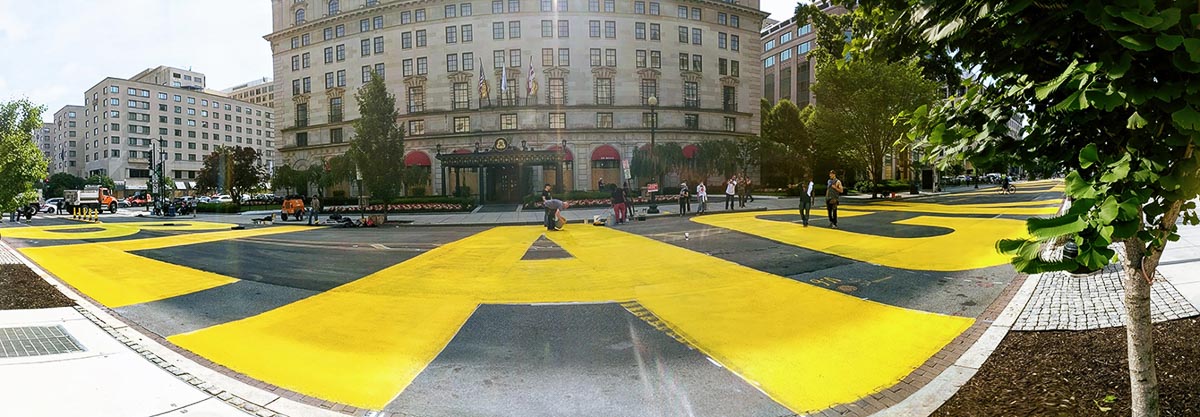The Golden Gate Bridge. Washington D.C.’s 16th Street. The Brooklyn Bridge. Houston’s State Highway 288. Minneapolis’ Interstate 94. Many of the protests over the murder of George Floyd, police brutality and systemic racism are taking over roadways. Similar protests took place in 2016 after a spate of police killings of black Americans.
Protestors are using public rights-of-way to voice anger and grief. They are marching on highways to call for justice and the remaking of our system of public safety. The power in such action is clear. Centering protest on highways disrupts commerce and the commutes of thousands of regional residents. There is an inherent inversion of power in the act of people stopping the motion of vehicles and a bringing a physical manifestation of our nation’s economy to a standstill.
Others have written about why the choice to protest racial injustice on highways is symbolic. Given the fraught history and ongoing issue of highways dividing and demolishing black and lower-income communities across the United States in the name of improved mobility, protesting racial injustice upon those very lanes carries a greater weight.
In these actions, public rights-of-way become far more than conduits for protest. They are contested sites where questions about access to — and safety within — public space intertwine with confronting police brutality, racial injustice and community disinvestment.
These actions are also assertions of citizenship. By turning highways into settings for protest, demonstrators are asserting what I call “infrastructural citizenship” in my book Power Moves. In this case, citizenship is not defined by nationality but by the act of reframing infrastructure as a deployable unit of political rhetoric and civic action. As a means to call for greater influence over the shape of our cities and systems that govern them; influence to which many black, brown and lower-income people rarely have had access.
In the protests, the demand for addressing police brutality and racial injustice has been carried out by bringing direct action onto the infrastructure that makes our cities run.
The protests also have a parallel in critical conversation about the ways we plan and use public space and public rights-of-way that have arisen in response to the COVID-19 pandemic. After numerous calls for cities to open streets for socially distanced recreation (a call that I responded to with great support), many black and brown urban planners, activists and communities have powerfully pointed out that more open space will not mean the same thing to every community and that not everyone will feel safe using them. Plans for more bike lanes or open space cannot succeed, these critiques point out, if the push for such elements doesn’t first work to address the underlying racial inequities at work on our streets and in our communities.
Inherent inequalities present in our infrastructure systems — highways that divide neighborhoods, crumbling local streets, poorly maintained public spaces and proximity to unhealthy industrial sites — impact black and brown communities far more than wealthier, predominately white neighborhoods. These are problems that arise from decades of racial inequality and disinvestment. Heavy policing and attached fears of violence make the streets feel less safe. Disproportionate rates of pedestrian and bicyclists injuries and deaths in black and brown communities make the streets feel anything but open to all.
The people drawing attention to these gaps have called on their professional peers (including myself and institutions such as the Kinder Institute) to listen to black and brown communities, to reflect upon what they hear, and to elevate and amplify ideas forwarded by black and brown residents instead of proscribing best practices or ideas that mesh with our worldviews.
The protests and planning critiques are a joint call to remake the approaches we take as we plan, build and govern our cities. They are calls to rethink who is at the table and whose voices are heard; to recognize and reckon with the legacies and current obstacles imposed by racism.
Infrastructure is the material on which we all live our lives, but more than that these systems reflect the constant negotiation of policies and politics taking place each day. How and where a highway is built or a sewer system is updated or a street is repaired; how a community is invested in or policed, all of these choices are tied to broader issues about race, power and access to decision-making in America.
We are all experiencing an era of extreme disruption, but this breaking also brings with it a chance to mend. This is a time to build new systems that help strengthen communities; to elevate the voices of those who have too often been left out. The protests, whether on the street or on the page, are offering paths to do so. But to walk those paths we have to grapple with the issues baked into the way our cities operate. We have to look with open eyes at the streets we walk and imagine together how we build them anew.
*Parts of this blog have been adapted and updated from earlier Urban Edge posts.

